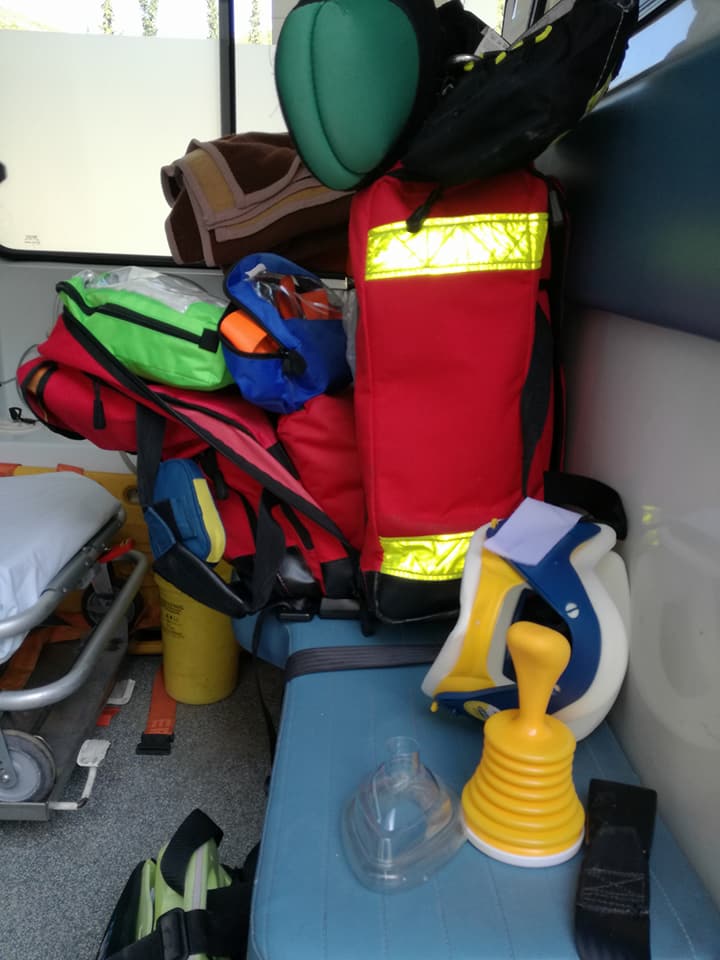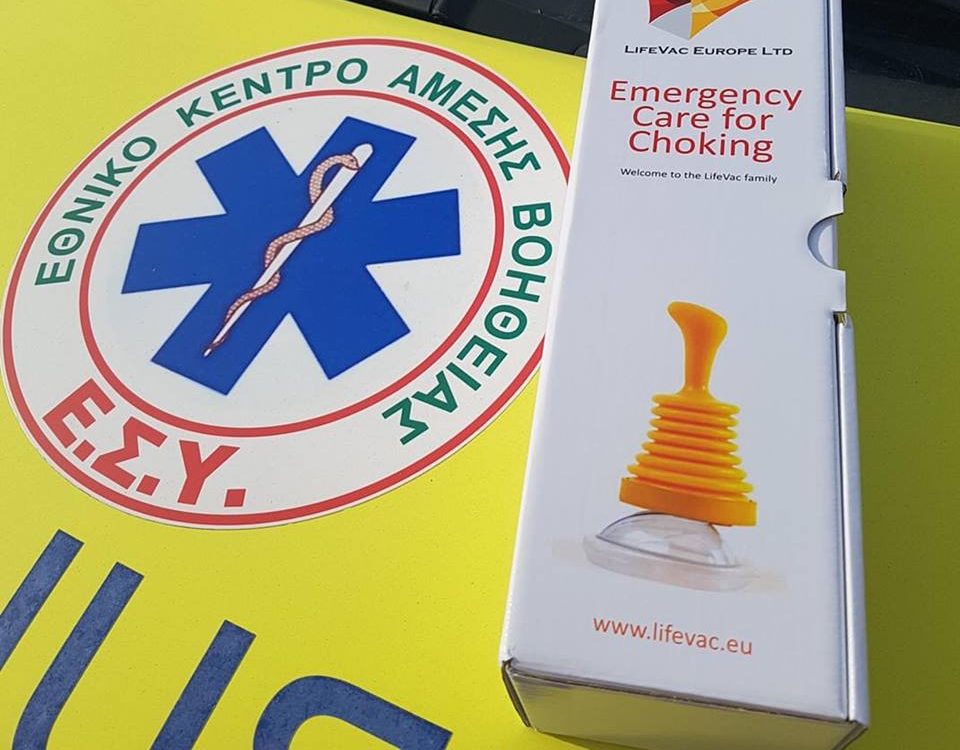
How To Save Someone’s Life If They Are Choking
November 29, 2016
Life Saved in Thessaloniki!
July 11, 2018Successful Use of the LifeVac to Resuscitate Choking Victims- Worldwide Results

Case No. 1, 2, 3: The incidents took place at an assisted living home in Wales. An 80 year-old female with dementia was eating lunch when suddenly she was noticed to be choking by the nursing home staff. Back slaps were attempted twice but with no result and the patient began losing consciousness. A nurse on duty then used the unit according to package directions and with one application the food bolus was successfully removed from the patient’s airway. The patient recovered without any adverse sequelae. One week later the same patient had a similar choking episode and once again the LifeVac was successfully used to resuscitate the patient.
In the same care home several months later, a 70 year-old male with Parkinson’s was noted to be choking while eating. The LifeVac was used per instructions and the obstructing food was successfully suctioned to the mouth where the nurse could then finger sweep it out.
Case No. 4: Another case of a life saved using LifeVac occurred on September 7, 2015 in New Jersey. The patient, a female, was 31 years old and is wheelchair bound. The patient suffers from dysphagia, or difficulty swallowing, since a young age. She began to choke on her tuna sandwich while eating lunch. Her mother unsuccessfully began performing abdominal thrusts. With the patient supine, the LifeVac successfully removed the obstructing food.
Case No. 5: On April 23, 2017 in Idaho, LifeVac was used in a private home. The device was bought for children who have had choking episodes. On April 23, it was used on a guest to the home, a 60 year old female with no medical issues who choked on a piece of meat during dinner. Abdominal thrusts were attempted right away, but unsuccessfully. The patient was the placed supine on her back on the floor. The LifeVac was then applied and with one suction, the piece of meat was removed from the airway. No adverse effects were noted.
Case No. 6: On September 6, 2017 in Spain in a Parkinson center, there was yet another life saved using LifeVac. The patient was an 80-year-old male who choked on meat while eating. A nurse attended to the patient, giving 5 back blows followed by 5 abdominal compressions. When these were unsuccessful, she applied the LifeVac per operating instructions and with four applications the food was dislodged.
Case No. 7: On October 4, 2017, LifeVac was used in a New York assisted living facility. The patient was an elderly male in a wheelchair who choked while eating a sandwich. The attendants were unable to perform abdominal thrusts due to his wheelchair status and instead used the LifeVac right away, which cleared the full airway blockage and dislodged the food. Later, a medical exam was performed including x-rays, which showed no adverse effects.
Case No. 8: On October 31, 2017 in Greece, the patient was a 40-year-old female who choked on a piece of garlic. EMS was called and arrived two minutes later. The emergency personnel performed abdominal thrusts as well as back blows but they were unsuccessful. Four minutes later, an EMS rescuer used LifeVac and with 3 attempts, the garlic piece was removed. The patient’s vital signs were all normal, and again no adverse events were reported. In addition the EMS team had a body camera and the entire resuscitation was captured on video.
Case No. 9: LifeVac was used on a 70 year old female with Huntingtons disease in a home care facility in the UK who choked on a sandwich during mealtime and become unconscious. The LifeVac was then used and required three pulls and the sandwich piece was successfully removed and was observed in the mask. The person operating the device was the 63 year old care manager. The patient briefly required CPR and was brought to the hospital where no adverse effects were reported and the patient was able to be returned to the home the next day.
Case No. 10: LifeVac was used successfully was in the United Kingdom where the patient was a 68-year-old male with Downs syndrome in a wheelchair who weighs 54 kg. The patient began choking on a piece of chocolate. A layperson saved the patient with 2 pumps of LifeVac and removed the obstruction successfully. Again. no adverse events were reported.
Case No. 4: Another case of a life saved using LifeVac occurred on September 7, 2015 in New Jersey. The patient, a female, was 31 years old and is wheelchair bound. The patient suffers from dysphagia, or difficulty swallowing, since a young age. She began to choke on her tuna sandwich while eating lunch. Her mother unsuccessfully began performing abdominal thrusts. With the patient supine, the LifeVac successfully removed the obstructing food.
Case No. 5: On April 23, 2017 in Idaho, LifeVac was used in a private home. The device was bought for children who have had choking episodes. On April 23, it was used on a guest to the home, a 60 year old female with no medical issues who choked on a piece of meat during dinner. Abdominal thrusts were attempted right away, but unsuccessfully. The patient was the placed supine on her back on the floor. The LifeVac was then applied and with one suction, the piece of meat was removed from the airway. No adverse effects were noted.
Case No. 6: On September 6, 2017 in Spain in a Parkinson center, there was yet another life saved using LifeVac. The patient was an 80-year-old male who choked on meat while eating. A nurse attended to the patient, giving 5 back blows followed by 5 abdominal compressions. When these were unsuccessful, she applied the LifeVac per operating instructions and with four applications the food was dislodged.
Case No. 7: On October 4, 2017, LifeVac was used in a New York assisted living facility. The patient was an elderly male in a wheelchair who choked while eating a sandwich. The attendants were unable to perform abdominal thrusts due to his wheelchair status and instead used the LifeVac right away, which cleared the full airway blockage and dislodged the food. Later, a medical exam was performed including x-rays, which showed no adverse effects.
Case No. 8: On October 31, 2017 in Greece, the patient was a 40-year-old female who choked on a piece of garlic. EMS was called and arrived two minutes later. The emergency personnel performed abdominal thrusts as well as back blows but they were unsuccessful. Four minutes later, an EMS rescuer used LifeVac and with 3 attempts, the garlic piece was removed. The patient’s vital signs were all normal, and again no adverse events were reported. In addition the EMS team had a body camera and the entire resuscitation was captured on video.
Case No. 9: LifeVac was used on a 70 year old female with Huntingtons disease in a home care facility in the UK who choked on a sandwich during mealtime and become unconscious. The LifeVac was then used and required three pulls and the sandwich piece was successfully removed and was observed in the mask. The person operating the device was the 63 year old care manager. The patient briefly required CPR and was brought to the hospital where no adverse effects were reported and the patient was able to be returned to the home the next day.
Case No. 10: LifeVac was used successfully was in the United Kingdom where the patient was a 68-year-old male with Downs syndrome in a wheelchair who weighs 54 kg. The patient began choking on a piece of chocolate. A layperson saved the patient with 2 pumps of LifeVac and removed the obstruction successfully. Again. no adverse events were reported.




